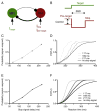Optimal performance in a countermanding saccade task
- PMID: 20034481
- PMCID: PMC2846395
- DOI: 10.1016/j.brainres.2009.12.018
Optimal performance in a countermanding saccade task
Abstract
Countermanding an action is a fundamental form of cognitive control. In a saccade-countermanding task, subjects are instructed that, if a stop signal appears shortly after a target, they are to maintain fixation rather than to make a saccade to the target. In recent years, recordings in the frontal eye fields and superior colliculus of behaving non-human primates have found correlates of such countermanding behavior in movement and fixation neurons. In this work, we extend a previous neural network model of countermanding to account for the high pre-target activity of fixation neurons. We propose that this activity reflects the functioning of control mechanisms responsible for optimizing performance. We demonstrate, using computer simulations and mathematical analysis, that pre-target fixation neuronal activity supports countermanding behavior that maximizes reward rate as a function of the stop signal delay, fraction of stop signal trials, intertrial interval, duration of timeout, and relative reward value. We propose experiments to test these predictions regarding optimal behavior.
Published by Elsevier B.V.
Figures






Similar articles
-
Relation of frontal eye field activity to saccade initiation during a countermanding task.Exp Brain Res. 2008 Sep;190(2):135-51. doi: 10.1007/s00221-008-1455-0. Epub 2008 Jul 5. Exp Brain Res. 2008. PMID: 18604527 Free PMC article.
-
Role of frontal eye fields in countermanding saccades: visual, movement, and fixation activity.J Neurophysiol. 1998 Feb;79(2):817-34. doi: 10.1152/jn.1998.79.2.817. J Neurophysiol. 1998. PMID: 9463444
-
Influence of history on saccade countermanding performance in humans and macaque monkeys.Vision Res. 2007 Jan;47(1):35-49. doi: 10.1016/j.visres.2006.08.032. Epub 2006 Nov 1. Vision Res. 2007. PMID: 17081584 Free PMC article.
-
Microsaccade production during saccade cancelation in a stop-signal task.Vision Res. 2016 Jan;118:5-16. doi: 10.1016/j.visres.2014.10.025. Epub 2014 Nov 6. Vision Res. 2016. PMID: 25448116 Free PMC article. Review.
-
Executive control of gaze by the frontal lobes.Cogn Affect Behav Neurosci. 2007 Dec;7(4):396-412. doi: 10.3758/cabn.7.4.396. Cogn Affect Behav Neurosci. 2007. PMID: 18189013 Review.
Cited by
-
Inhibitory control in mind and brain 2.0: blocked-input models of saccadic countermanding.Psychol Rev. 2015 Apr;122(2):115-47. doi: 10.1037/a0038893. Epub 2015 Feb 23. Psychol Rev. 2015. PMID: 25706403 Free PMC article.
-
The countermanding task revisited: mimicry of race models.J Neurosci. 2013 Jul 24;33(30):12150-1. doi: 10.1523/JNEUROSCI.2091-13.2013. J Neurosci. 2013. PMID: 23884923 Free PMC article. No abstract available.
-
Cognitive control and automatic interference in mind and brain: A unified model of saccadic inhibition and countermanding.Psychol Rev. 2020 Jul;127(4):524-561. doi: 10.1037/rev0000181. Epub 2020 Jan 30. Psychol Rev. 2020. PMID: 31999149 Free PMC article.
-
Measurement of the extraocular spike potential during saccade countermanding.J Neurophysiol. 2011 Jul;106(1):104-14. doi: 10.1152/jn.00896.2010. Epub 2011 Apr 13. J Neurophysiol. 2011. PMID: 21490279 Free PMC article.
-
Production, control, and visual guidance of saccadic eye movements.ISRN Neurol. 2013 Oct 23;2013:752384. doi: 10.1155/2013/752384. eCollection 2013. ISRN Neurol. 2013. PMID: 24260720 Free PMC article. Review.
References
-
- Bogacz R, Brown E, Moehlis J, Holmes P, Cohen JD. The physics of optimal decision making: a formal analysis of models of performance in two-alternative forced choice tasks. Psychol Rev. 2006;113:700–765. - PubMed
-
- Boucher L, Palmeri TJ, Gordan GD, Schall JD. Inhibitory control in mind and brain: an interactive race model of countermanding saccades. Psych Rev. 2007;114:376–397. - PubMed
-
- Cutsuridis V, Smyrnis N, Evdokimidis I, Perantonis S. A neural model of decision-making by the superior colliculus in an antisaccade task. Neural Netw. 2007;20:690–704. - PubMed
-
- Everling S, DeSouza JF. Rule-dependent activity for prosaccades and antisaccades in the primate prefrontal cortex. J Cogn Neurosci. 2005;17:1483–1496. - PubMed
Publication types
MeSH terms
Grants and funding
LinkOut - more resources
Full Text Sources

